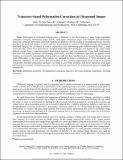Trajectory-based Deformation Correction in Ultrasound Images
Author(s)
Sun, Shih-Yu; Anthony, Brian; Gilbertson, Matthew W.
DownloadShih-Yu-2010-Trajectory-based Deformation.pdf (734.9Kb)
PUBLISHER_POLICY
Publisher Policy
Article is made available in accordance with the publisher's policy and may be subject to US copyright law. Please refer to the publisher's site for terms of use.
Terms of use
Metadata
Show full item recordAbstract
Tissue deformation in ultrasound imaging poses a challenge to the development of many image registration techniques, including multimodal image fusion, multi-angle compound image and freehand three-dimensional ultrasound. Although deformation correction methods are desired to provide images of uncompressed tissue structure, they have not been well-studied. A novel trajectory-based method to correct a wide range of tissue deformation in ultrasound imaging was developed. In order to characterize tissue deformation under different contact forces, a force sensor provides contact force measurement. Template based image-flow techniques were applied to RF A-lines under different contact forces. A two-dimensional displacement trajectory field was constructed, where pixel coordinates in each scan were plotted against the corresponding contact force. Nonlinear extrapolation algorithms are applied to each trajectory to relocate the corresponding pixel to where it would have been had there been no contact, thereby correcting tissue deformation in the images. This method was validated by using a combination of FEM deformation and ultrasound simulation. It was shown that deformation of the simulated pathological tissue could be corrected. Furthermore, nonlinear polynomial regression was found to give better estimates, than linear regression, when large deformation was present. Estimation accuracy was not improved significantly for a polynomial regression larger than second order.
Date issued
2010-03Department
Massachusetts Institute of Technology. Department of Electrical Engineering and Computer Science; Massachusetts Institute of Technology. Laboratory for Manufacturing and ProductivityJournal
Proceedings of the Society of Photo-optical Instrumentation Engineers
Publisher
SPIE
Citation
Sun, Shih-Yu, Brian W. Anthony, and Matthew W. Gilbertson. “Trajectory-based deformation correction in ultrasound images.” Medical Imaging 2010: Ultrasonic Imaging, Tomography, and Therapy. Ed. Jan D'hooge & Stephen A. McAleavey. San Diego, California, USA: SPIE, 2010. 76290A-9. © 2010 SPIE.
Version: Final published version
Other identifiers
Proc. of SPIE Vol. 7629 76290A-1
ISSN
0277-786X